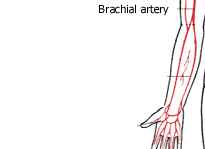|
Increasing
the response of prosthetics
Nano-machines , because of their small size and advanced
programming, as well as large numbers, can increase reaction
speed in a machine or other device. This proposes a
possibility that prosthetics could be made with
nanotechnology to operate nearly instantaneously, just as a
human arm would, by reading the neural patterns in a persons
brain and transmitting them to the prosthetic at speeds as
quick as the biological system. Signals sent from the brain
that are meant for very small movements could be read by the nanobots and reported to the prosthetic device giving
amputees the freedom to move all five fingers in very fine
ways. Another possibility is that the actual machinery
inside a prosthetic arm could be replaced with nanobots that
can operate seamlessly and do not have the slow, heavy, machine
"feel" that current robotic prosthetics do. Another advantage
of nanotechnology is that, because they are a group of
millions of minute machines rather than one large machine,
they require almost no power to operate and can, in theory,
run off the bio-electric field of a human
being.
Transmitting through the human body
The microscopic size of nanobots limits their
transmitting range. There would need to be millions
upon millions of them in a person's blood stream to
thoroughly transmit the neuron signals from the brain to the
muscles of the body. Fortunately, having millions of nanobots
inside your body does not pose even a slight health risk.
However, there are problems.
For example, after injecting nanobots into a person's
bloodstream, how do they get to the precise locations in the
amputee's limb where they can
operate properly? This problem can be overcome by using our
knowledge of the human circulatory system (Ceren, 2003). Nanobots
can be injected at a point where they will flow to the
cluster of blood vessels that gather at the amputee's
partial appendage and they will be programmed to stay there
and form a chain at specific points of the neural network.
This will enable them to transmit neural signals to the
prosthetic. Once the nanobots are correctly positioned they can
begin transmitting signals and the amputee will have a
prosthetic that needs no batteries and simulates, in a more
real way, the operations of a human limb.
|
 |
| (American
Medical Association, 2003). |
By injecting nanobots into
the brachial artery, they would naturally flow to the
cluster of blood vessels at the amputee's limb where they
would begin to form a chain up the appendage and into the
midbrain area of the brain stem which controls muscle
movement (Johnson,2002). In this way, neural signals can be
relayed nearly instantaneously to the "nanobotic" prosthetic
arm.
We believe Nano-technology could make prosthetics for future patients as
efficient as possible and the closest thing they will have
to real limbs. Until then, those currently researching
the ways robotics can be used must stick to simpler
solutions.
One simpler solution we
have been working on is the idea of proprioceptive feeling.
The arm or leg of a human develops a wide range of motion
and we know when our limbs are in certain positions based on
that feeling. For example, we can reach over and turn
on a light switch without actually looking at our arm and
where it goes. For those who have lost even part of a
limb, the proprioceptive feeling changes drastically.
One way to allow some of
the proprioceptive feeling back might be to place sensors in
the prosthesis that can determine whether it is up or down,
in front of the person or behind the person. Once
these spatial sensors are calibrated during the rehab
process, they will communicate by emitting a small
electrical pulse to various parts of the partial appendage.
In this way, we hope to restore some of the proprioceptive
feeling that is lost when one loses a limb.
We believe that
advancements of this kind might help us produce successful
ways to better the lives of those who have lost limbs.
The future of research and development in the area of
prosthetics looks promise a life of more comfort and
convenience for amputees. |
![]()
![]()
![]()
![]()
![]()